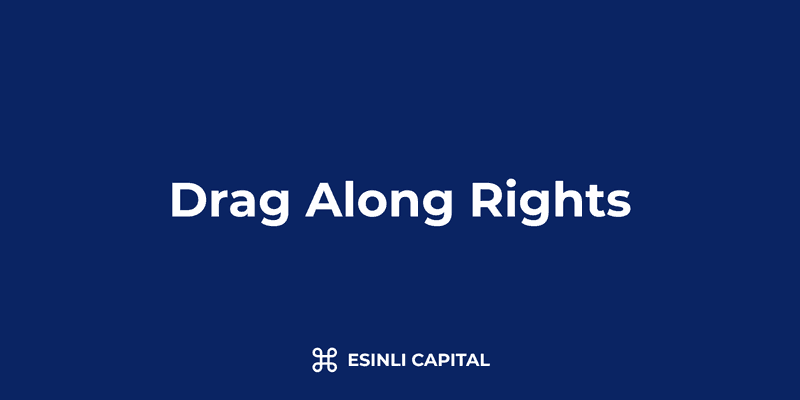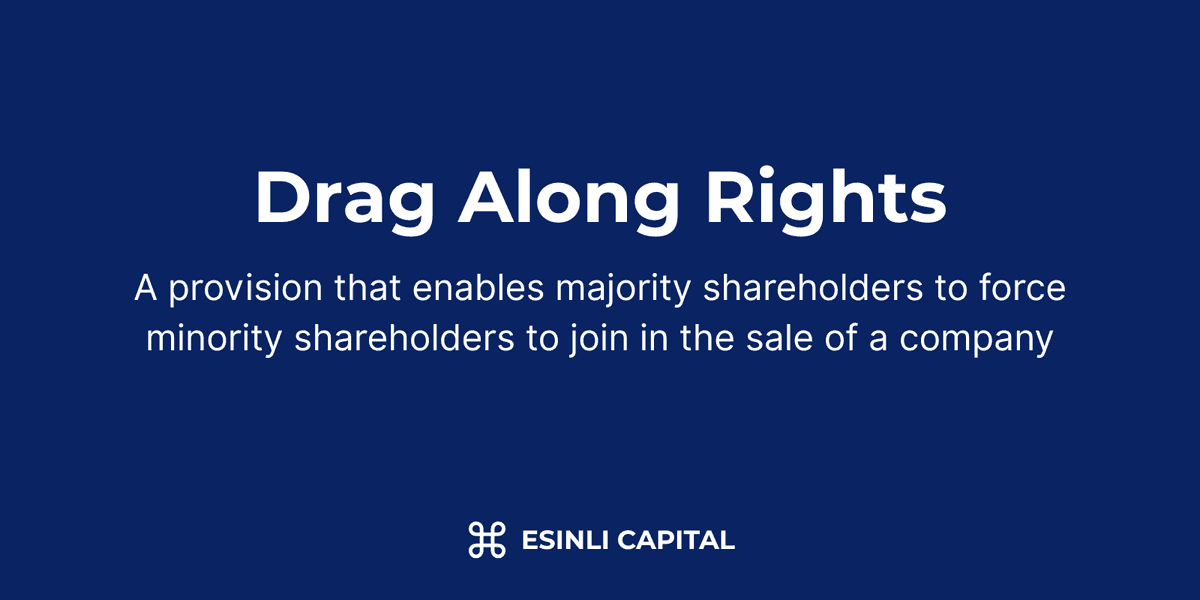In This Article
- What Are Drag Along Rights?
- Why Are Drag Along Rights Important?
- Drag Along Rights vs. Tag Along Rights
- How to Implement Drag Along Rights
- Negotiating Drag Along Rights
- Drag Along Rights by Company Stage
- Potential Problems and Limitations
- Real-World Examples and Case Studies
- Drag Along Rights: How to Structure Them
- Drag Along Rights vs. Other Exit Mechanisms
- The Bottom Line
- FAQs
- What Are Drag Along Rights?
- Why Are Drag Along Rights Important?
- Drag Along Rights vs. Tag Along Rights
- How to Implement Drag Along Rights
- Negotiating Drag Along Rights
- Drag Along Rights by Company Stage
- Potential Problems and Limitations
- Real-World Examples and Case Studies
- Drag Along Rights: How to Structure Them
- Drag Along Rights vs. Other Exit Mechanisms
- The Bottom Line
- FAQs

Drag Along Rights: Purpose, Implementation & Negotiation Strategies
KEY TAKEAWAYS
- Drag along rights allow majority shareholders to force minority shareholders to participate in a company sale on the same terms
- These rights are primarily designed to facilitate clean exits and prevent minority shareholders from blocking valuable acquisition opportunities
- Voting thresholds typically range from 50-90% and are a critical negotiation point between founders and investors
- Well-structured drag along clauses include price minimums, board approval requirements, and equal treatment provisions to protect all parties
- Drag along rights differ from tag along rights, which give minority shareholders the option (not obligation) to join in a company sale
What Are Drag Along Rights?
Drag along rights are provisions in shareholder agreements that grant majority shareholders the power to force minority shareholders to participate in the sale of a company. When a majority shareholder (or group of shareholders) receives an acquisition offer they wish to accept, drag along rights "drag" the minority shareholders into the same transaction under identical terms and conditions.
These provisions are staples in most shareholder agreements, term sheets, and investment documents, particularly for venture-backed startups and private companies with multiple investor groups. They serve as essential mechanisms to ensure clean exits and prevent small shareholders from creating obstacles during potential acquisition opportunities.
How Drag Along Rights Function in Practice
In practical terms, drag along rights work as follows:
- Acquisition offer received: A potential buyer makes an offer to acquire the company
- Majority approval: Shareholders meeting the required threshold (e.g., those holding 75% of shares) vote to accept the offer
- Rights activated: Once approved by the majority, the drag along provision is triggered
- Mandatory participation: Minority shareholders must sell their shares at the same price and on the same terms as the majority
- Transaction completed: This creates a "clean exit" with 100% of shares transferred to the acquirer
For example, if investors holding 80% of a company's shares find a buyer willing to acquire the entire business for $100 million, minority shareholders holding the remaining 20% cannot refuse to sell if valid drag along rights are in place. This prevents a small group of shareholders from blocking what might be an advantageous exit for the company as a whole.
Why Are Drag Along Rights Important?
Drag along provisions serve several critical purposes in the venture capital ecosystem and private company governance:
1. Facilitating Clean Exits
The primary purpose of drag along rights is to ensure that acquirers can purchase 100% of a company without holdout problems. Most acquirers are unwilling to purchase a company unless they can obtain full ownership, as minority shareholders could potentially create complications post-acquisition.
2. Maximizing Company Value
By removing the risk of minority shareholders blocking an acquisition, drag along rights can increase a company's attractiveness to potential buyers. This often translates to higher valuation offers since the acquirer has certainty that the transaction can be completed efficiently.
3. Aligning Shareholder Interests
These provisions help align the interests of all shareholders by ensuring everyone receives the same terms in an exit scenario. This prevents situations where majority shareholders might negotiate preferential treatment at the expense of minority stakeholders.
4. Preventing Holdout Strategies
Without drag along rights, minority shareholders might attempt to extract additional benefits by refusing to sell their shares, potentially jeopardizing the entire transaction. These provisions eliminate such holdout strategies.
5. Creating Liquidity Options
For early-stage investors and founders, drag along rights provide assurance that a viable exit path exists when a qualified offer arrives, even if some shareholders might prefer to continue operating independently.
Drag Along Rights vs. Tag Along Rights
Though they sound similar, drag along and tag along rights serve different purposes and protect different stakeholder groups:
| Feature | Drag Along Rights | Tag Along Rights |
|---|---|---|
| Primary beneficiary | Majority shareholders | Minority shareholders |
| Nature | Obligation to sell | Option to sell |
| Trigger | Majority decision to sell | Majority shareholder selling shares |
| Purpose | Facilitate complete company exits | Prevent selective exits that disadvantage minorities |
| Control aspect | Limits minority blocking power | Limits majority's ability to exit alone |
| When exercised | During full company acquisitions | During partial or selective share sales |
While drag along rights compel minority shareholders to join in a sale, tag along rights give minority shareholders the option (but not obligation) to sell their shares under the same terms if majority shareholders decide to sell theirs.
How to Implement Drag Along Rights
Effective implementation of drag along provisions requires careful consideration of several key elements:
Essential Components of Drag Along Clauses
A well-structured drag along provision typically includes:
- Voting threshold definition: Specifies the percentage of shareholders required to approve a sale (e.g., 66%, 75%, or 90%)
- Price and terms conditions: Ensures all shareholders receive identical terms
- Notice requirements: Establishes how much advance notice minority shareholders must receive
- Procedural requirements: Outlines the specific steps needed to exercise the rights
- Exclusions and limitations: Defines scenarios where the provision might not apply
- Information rights: Guarantees minority shareholders receive adequate information about the proposed transaction
Typical Voting Thresholds
The required majority threshold for triggering drag along rights varies based on company stage, investor leverage, and negotiation outcomes:
- Early-stage startups: Often 50-66% (favors investors)
- Growth-stage companies: Typically 66-75% (balanced approach)
- Mature private companies: Sometimes 75-90% (more founder/management protection)
A higher threshold provides greater protection for minority shareholders, while a lower threshold makes it easier for majority investors to force an exit.
Legal Documentation Requirements
Drag along rights must be properly documented to be enforceable:
- Shareholder agreements: The most common place for these provisions
- Investment agreements: Often included in Series A and later funding rounds
- Articles of incorporation/association: May be incorporated into company bylaws
- Side letters: Sometimes addressed in supplementary agreements
Legal counsel should review these provisions to ensure they comply with relevant corporate law in the company's jurisdiction of incorporation.
Negotiating Drag Along Rights
The negotiation of drag along provisions represents a critical balancing act between majority control and minority protection:
From the Majority Shareholder Perspective
Majority shareholders (often institutional investors) typically seek:
- Lower voting thresholds: Making it easier to approve a sale (e.g., simple majority)
- Broad application: Ensuring the provision covers all types of transactions
- Minimal exceptions: Limiting scenarios where minorities can block a sale
- Streamlined process: Creating an efficient mechanism to execute the provision
From the Minority Shareholder Perspective
Founders and minority investors typically focus on:
- Higher voting thresholds: Requiring a supermajority (e.g., 75-90%) to approve a sale
- Minimal price guarantees: Ensuring the sale price meets or exceeds certain valuation metrics
- Board approval requirements: Adding a governance layer of protection
- Equal treatment provisions: Guaranteeing identical terms for all shareholders
- Time limitations: Preventing activation during early company stages
- Founder employment protections: Addressing post-acquisition employment terms
Balance and Compromise: Best Practices
The most effective drag along provisions balance the needs of all stakeholders:
- Graduated thresholds: Higher requirements in early years, decreasing over time
- Qualified buyer provisions: Limitations on who can be an acceptable acquirer
- Minimum return multiples: Ensuring investors receive adequate returns before rights activate
- Specific exclusions: Protecting against certain types of unfavorable transactions
- Information rights: Guaranteeing transparent communication throughout the process
- Independent valuation options: Allowing for third-party valuation in disputed cases
Drag Along Rights by Company Stage
The implementation and negotiation of these provisions evolve as companies mature:
Early-Stage Startups
In seed and Series A rounds:
- Typically introduced by the first institutional investors
- Often negotiated with less experienced founders
- Usually have higher thresholds (70-85%)
- May include founder-friendly provisions like minimum valuation requirements
- Sometimes include time restrictions (not applicable in first 3-5 years)
Growth-Stage Companies
By Series B and C:
- More standardized provisions as additional investors join
- Thresholds often drop to 66-75%
- More sophisticated minority protections emerge
- Often modified with each funding round
- Balance increasingly tips toward investor control
Pre-IPO and Mature Companies
For later-stage private companies:
- Usually settled at 50-66% thresholds
- More exceptions and qualifications added
- Increasingly focused on liquidity event planning
- Often includes specific scenarios for different exit types
- May address international and regulatory considerations
Potential Problems and Limitations
While essential for governance, drag along rights do present certain risks and challenges:
Legal Challenges to Enforcement
Courts may scrutinize drag along provisions, particularly when:
- The terms appear unfair to minority shareholders
- Procedures weren't properly followed
- Conflicts of interest exist among majority shareholders
- Notice requirements weren't adequately met
- The provision conflicts with local corporate law
Jurisdictional Variations
Implementation varies significantly across legal jurisdictions:
- US approach: Generally enforced if properly documented
- UK approach: Subject to unfair prejudice claims in some cases
- Continental Europe: Often requires additional formalities
- Emerging markets: May have weaker enforcement mechanisms
Balancing Power Dynamics
Potential governance issues include:
- Majority shareholders forcing premature exits
- Interested director conflicts during board approvals
- Information asymmetry between shareholder groups
- Valuation disputes between parties
- Post-closing indemnification concerns
Real-World Examples and Case Studies
Successful Applications
Tech Startup Acquisition A venture-backed SaaS company with five investor groups received an acquisition offer from a strategic buyer at 4x the last valuation. While two angel investors (holding 8% combined) opposed the sale, the drag along provision (triggered at 70%) allowed the transaction to proceed, resulting in a $250M exit that benefited all shareholders.
Family Business Transition A family-owned manufacturing business with three generations of shareholders used drag along rights to facilitate a private equity buyout when 85% of shareholders approved the transaction, despite resistance from minority family members who wanted to maintain independence.
Problematic Scenarios
Disputed Valuation Case A biotech startup's majority investors triggered drag along rights to sell the company for $40M. Founding scientists who held 15% argued the valuation severely undervalued key patents and unsuccessfully challenged the provision in court, highlighting the importance of minimum price protections.
Conflicted Transaction In a controversial case, a venture fund with board representation used drag along rights to sell a portfolio company to another entity it controlled at a valuation minority shareholders claimed was below market. The resulting litigation led to a settlement and revised transaction terms.
Drag Along Rights: How to Structure Them
The practical implementation of drag along rights requires careful drafting of specific provisions:
Key Clauses and Language
Essential elements in a well-drafted provision include:
"If shareholders holding at least [X%] of the Company's [voting shares/all shares] (the "Selling Shareholders") accept a bona fide offer from any person or entity (the "Buyer") to purchase all shares of the Company, then upon request by the Selling Shareholders, each holder of shares (the "Dragged Shareholders") shall be required to sell all their shares to the Buyer on the same terms and conditions as the Selling Shareholders."
Additional clauses typically address:
- Information rights and notice periods
- Procedure for executing the sale
- Representations and warranties requirements
- Treatment of options and convertible securities
- International transaction considerations
Protective Mechanisms
To balance stakeholder interests, consider incorporating:
-
Minimum price floors: "The drag along right may only be exercised if the per-share consideration exceeds [X] times the original purchase price."
-
Board approval requirements: "Any sale pursuant to this provision must be approved by a majority of the Board of Directors, including at least one director representing [minority shareholder class]."
-
Look-back provisions: "If within 12 months following the transaction, the Buyer resells the Company at a higher valuation, Dragged Shareholders shall be entitled to their pro rata share of the increased consideration."
Drag Along Rights vs. Other Exit Mechanisms
Drag along rights exist within a broader ecosystem of shareholder exit provisions:
| Mechanism | Purpose | Who Controls | When Used |
|---|---|---|---|
| Drag Along Rights | Force complete company sale | Majority shareholders | Company-wide exits |
| Tag Along Rights | Allow minorities to join sale | Minority shareholders | Partial exits |
| Right of First Refusal | Control who can buy shares | Company or existing shareholders | Share transfers |
| Redemption Rights | Force company to buy shares | Typically investors | Liquidity before exit |
| Put Options | Right to sell at predetermined price | Option holder | Planned exits |
| Call Options | Right to buy at predetermined price | Option holder | Consolidating control |
These mechanisms often work together to create a comprehensive framework for managing shareholder exits and company transitions.
The Bottom Line
Drag along rights represent a fundamental component of shareholder agreements that balance the competing interests of various stakeholder groups. When properly structured, they facilitate clean exits that maximize value for all shareholders while providing appropriate protections against abuse.
For founders, understanding these provisions before signing investment agreements is crucial, as they directly impact control over company destiny. For investors, carefully crafted drag along rights provide essential exit assurances. And for companies as a whole, these provisions create governance clarity that can enhance overall company value.
The most successful implementations strike a careful balance: empowering majority shareholders to pursue value-creating transactions while protecting minority stakeholders with appropriate safeguards and equal treatment guarantees. With thoughtful negotiation and proper legal documentation, drag along rights serve as valuable tools that align incentives toward optimal outcomes for all parties involved in the entrepreneurial journey.
FAQs
What voting percentage typically triggers drag along rights?
The voting threshold varies widely from 50% to 90%, with most falling in the 66-75% range. Early-stage companies often have higher thresholds (protecting founders), while later-stage companies typically have lower thresholds (facilitating exits).
Can founders be protected from drag along rights?
Founders can negotiate protections like minimum price requirements, extended vesting provisions, management retention agreements, and higher voting thresholds. However, completely eliminating drag along rights is rare in venture-backed companies.
How do drag along rights affect employee shareholders?
Employees holding equity are typically subject to the same drag along provisions as other shareholders. However, acquirers often implement retention packages for key employees as part of the transaction structure.
Can drag along rights be challenged in court?
Yes, drag along rights can be challenged, particularly if: (1) the procedure wasn't properly followed, (2) there are conflicts of interest, (3) the transaction terms are demonstrably unfair, or (4) the provision violates local corporate law. However, well-documented provisions in properly executed agreements are generally enforceable.
Do drag along rights apply to preferred shareholders?
Yes, drag along rights typically apply to all shareholders, including preferred. However, preferred shareholders often negotiate special provisions requiring that their liquidation preferences be honored before drag along rights can be exercised.



